Toy Poodle: Dog Breed Characteristics & Care
History, Care Tips, and Helpful Information for Pet Owners
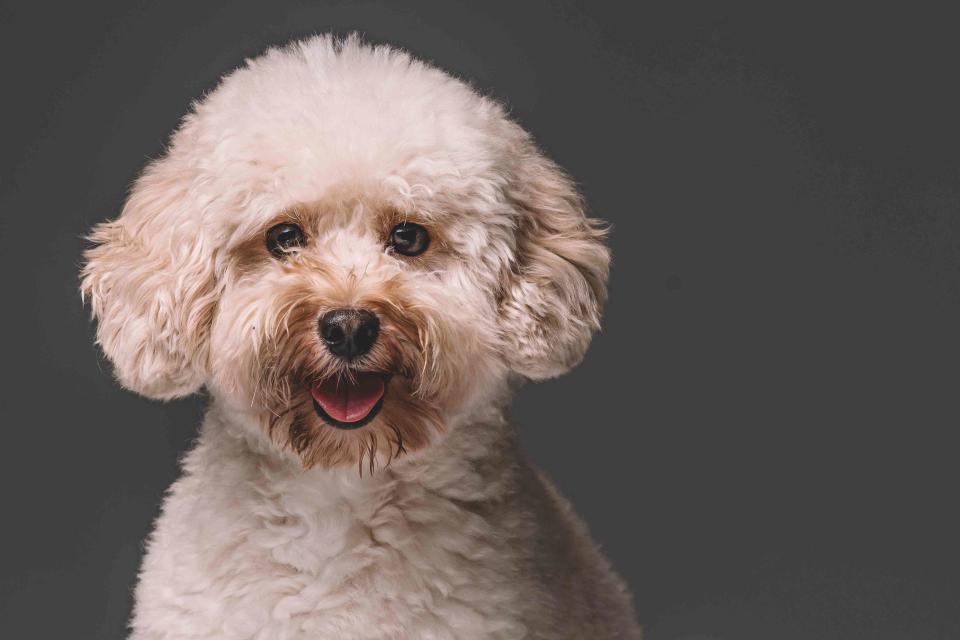
chee gin tan / Getty Images
Toy poodles, along with standard poodles and miniature poodles, are famously known for their proven excellence in shows. Their curly and voluminous coat in combination with a confident strut always seems to steal the show. To boot, the breed is intelligent, athletic, and loyal, making it a great choice for single owners and families alike.
Breed Overview
GROUP: Toy
HEIGHT: 8 to 10 inches
WEIGHT: 6 to 9 pounds
COAT: Curly and dense
COAT COLOR: Apricot, black, blue, brown, cafe au lait, cream, gray, red
LIFE SPAN: 14 to 17 years
TEMPERAMENT: Confident, loyal, intelligent, lively, alert
HYPOALLERGENIC: Yes
ORIGIN: France, Germany
Characteristics of the Toy Poodle
Toy poodles are charismatic family pets that love to be the center of attention. They are highly intelligent and take well to obedience training, but can suffer from separation anxiety due to their companionable nature. They do well around children and other pets and are well-suited to life in smaller spaces thanks to their petite size.
Affection Level | High |
Friendliness | High |
Kid-Friendly | Medium |
Pet-Friendly | Medium |
Exercise Needs | Low |
Playfulness | Medium |
Energy Level | Medium |
Trainability | High |
Intelligence | High |
Tendency to Bark | Medium |
Amount of Shedding | Low |
History of the Toy Poodle
The poodle was bred to be a duck hunting dog in Germany over 400 years ago, where its thick curly coat came in handy to protect against the cold. Their athletic skills and eagerness to please made them perfect retrievers.
The exaggerated show cut that poodles are often recognized for today stemmed from their historic days of retrieving. Hunters would cut the dogs’ coats to ensure they had free range of movement while also having adequate protection from the elements. So, hunters would shave their poodle’s legs, neck, and tail. Their chest, hips, and leg joints would still be covered with curly hair in rounded tufts.
Poodles have three variations—standard, miniature, and toy. The standard poodle is the oldest of these varieties and the miniature and toy variations were eventually created for those who desired smaller dogs. Despite their small size, toy and miniature poodles were working dogs. Toy poodles, specifically, have historically been desired for circuses due to their high intelligence and athleticism.
The toy poodle was first bred in the early 20th century as a companion dog, especially great for those living in apartments or smaller spaces. The poodle was first recognized by the American Kennel Club in 1886 and the Poodle Club of America was founded ten years later. Today, poodles are exceedingly popular among pet owners, especially those in France. In fact, the poodle is the national dog of France.

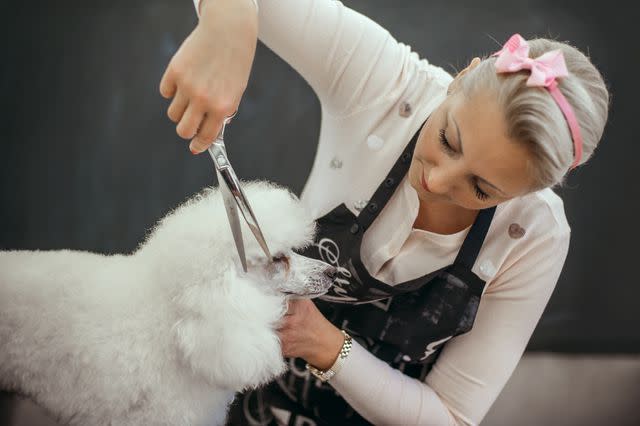

Toy Poodle Care
Though poodles have gained a reputation of being fancy and high-maintenance, they really are no harder to care for than the average dog. In particular, toy poodles are considered the easiest of the bunch, due to their small size—acts like grooming and exercise will take no time at all thanks to their petite frame.
Exercise
While larger standard poodles need plenty of room and exercise to thrive, smaller toy poodles do not. However, they are still an active breed and love going for daily walks with their loved ones. They also love swimming, retrieving, and performing tricks to burn off energy.
Grooming
Due to the toy poodle’s thick and curly coat, owners will need to brush their dogs daily from root to end to prevent any matting. If their coat develops mats, toy poodles may need to be shaved quite short to give their hair a chance to grow back nicely. Fine-toothed combs with sturdy teeth are great options to keep in your toy poodle grooming kit—they get the job done well without causing a significant amount of discomfort for the dog.
Toy poodles don’t shed, making them a great pet for people with allergies. Still, some owners prefer to keep their toy poodle’s coat cut short to reduce the chance of matting and make clean-up after a muddy play session a little easier. Owners may opt to do the trimming themselves with a pair of clippers or head to a pro every six weeks for a cut, bath, and nail trim. Luckily, it’s easy to train a toy poodle to behave at the groomer.
70 Cute and Classy Poodle Names
Training
Toy poodles are an intelligent breed and absolutely love to please their owner. As active and graceful dogs, they excel at sporting activities. This may come as a shock to those who believe poodles are prissy or feminine—a common misconception. Toy poodles are great at learning and performing tricks.
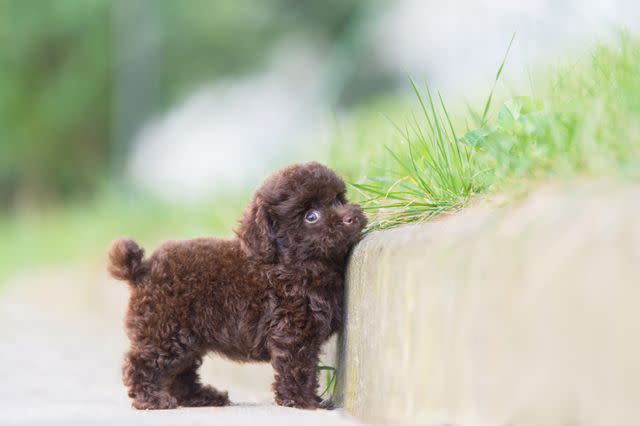
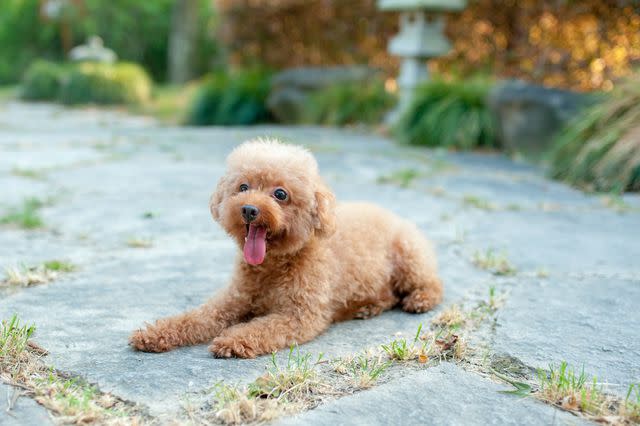
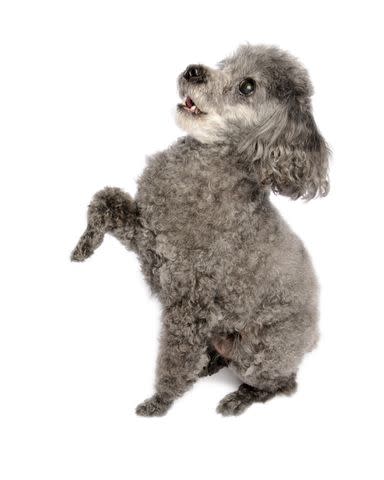
Common Health Problems
Purebred toy poodles are generally healthy, but as with any pet, there are health risks. Always make sure to get your toy poodle from a reputable breeder who tests their puppies for common health problems and can provide you with medical paperwork before you commit.
Some health problems to watch out for in toy poodles include:
Diet and Nutrition
The best food for your dog will depend on its size and activity level. Because toy poodles are small in size, they don’t require a large number of calories each day. If they are fed above their ideal caloric level, they may become overweight or even obese without proper exercise to burn it off. It’s important to work with your vet to find the right food for your pet and the portion control required to keep them healthy.
Whether you choose wet, raw, or dry food, you should go for something relatively high in protein and fiber, but without too many fillers like corn bran or oat hulls. The ideal dog food should contain mostly whole foods and quality sources of protein, including things like real meat and vegetables.
Where to Adopt or Buy a Toy Poodle
If you decide to purchase your toy poodle from a breeder, make sure that they are reputable. Top-notch breeders may have certifications or awards and they are always honest about health concerns and can provide their customers with health information for their puppies.
Toy poodle rescues often cannot provide that level of information on their puppies. However, the heartwarming thing about adopting is that you know you are giving a dog a happier and healthier life than they had before. To buy or adopt a toy poodle puppy, check out:
Be sure to check out options local to you, too. There are reputable breeders across the country and local rescues, even if they aren’t breed-specific, often have toy poodles up for adoption.
Toy Poodle Overview
Pros
Suitable for small spaces
Smart and eager to please
Low shedding
Cons
High grooming needs
Can bark loudly
Prone to dental issues
15 Best Dogs Breeds for Apartments or Condos
More Dog Breeds and Further Research
When deciding whether a toy poodle is the right fit for your family, more research is always better. Talk to fellow poodle owners, your vet, and local breeders to ensure you have a good grasp on what it takes to be a toy poodle owner.
If you're interested in similar breeds, check out:
There’s a whole world of potential dog breeds out there—with a little research, you can find the right one to bring home!
Frequently Asked Questions
Are toy poodles good apartment dogs?
The toy poodle’s small size means they can be happy in small spaces without overwhelming amounts of strenuous activity. Because of that, toy poodles make great pets for apartment dwellers and dog lovers without the ability to commit to an exceedingly high-energy breed.
Are toy poodles aggressive?
In general, toy poodles are not aggressive. However, because of their size, they can sometimes become intimidated by other animals or rough handling by humans. This overwhelm can cause them to act out, but it's nothing they can't be trained to work through.
What is the difference between a toy poodle and a miniature poodle?
The only difference between a toy poodle and a miniature poodle is size. Miniature poodles are generally 11 to 15 inches tall, while toy poodles top out at no taller than 10 inches.
Read the original article on The Spruce Pets.

